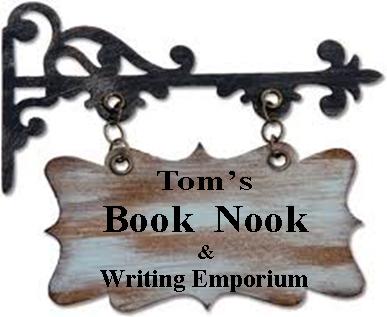SITE MENU
THE QUESTION AND RESPONSE PAGE
(Your Questions. My Responses.)
On this page I will answer your questions about writing. Understand the responses will be from my perspective and there may well be lots of perspectives related you your inquiry.
At any rate, ask away. Please keep the questions short, to the point, and clear.
PROCEDURE: SEND YOUR QUESTION TO drwriterguy (at) netscape.net
Put Q & R on subject line.
I'll add newer questions at the top. No name will be attached to your question here on this site.
Here is one of
my books all
about writing
using a method
I often employ.
MILIEU: offering
an alternative
approach to
writing, in which the characters
lead the way rather than an author's pre-planned story-line. Drop a character or two into a setting (the milieu) and let them go at it. Great fun! This is a step by step tutorial and is illustrated with the writing of a short novel with billions of explanatory notes.
By Tom Gnagey
At this time
only available on
Nook.
8-11-13
Q- In a talk you gave recently you mentioned something you called ‘naked nouns and verbs’. Can you say more about that, please?
R- It is, perhaps, less R or X rated than it might sound. Lots of writing teachers don’t agree with me on this but let me try - and, understand, I am speaking more about short stories than longer pieces.
Let’s begin with an example – well, two examples:
“The man had difficulty using the steps.”
“The old man with the distinctive limp had extreme difficulty using the crumbling, ancient, cement steps.”
If you read my response to Q-3 you will remember the term ‘plumping’. This is akin to that. ‘Man’ standing in the first example is naked – unadorned, unmodified. He could be young, old, black, pink, sick, happy and so on. To assist with quick characterization – which I think is essential in short pieces – adorn your naked nouns and verbs immediately. Quite simply, in the second example, man became ‘old man’. Not only that, I extended the ‘garb’ to include ‘distinctive limp’ (it is an extension of the terms ‘crippled’ that could have been inserted ahead of ‘old’.) ‘Difficulty’ became ‘extreme’. ‘Steps’, became dressed as ‘cement’. ‘Cement’ became less naked with the additions of ‘crumbling’ and ‘ancient’. All that could have also been said by adding a half dozen sentences, but that poses lots of unfair problems for the reader (below).
Briefly, a naked verb or noun just sits there all quite apathetically, when with a little adornment, it can become filled out, its meaning augmented and expanded on the spot. I believe the process provides a great advantage to the reader because it helps draw the necessary picture all at once. If at first he just has steps, who knows what picture he may create in his mind. To fulfill the needs of this story it can’t be just any set of steps – it has to be ancient, crumbling, cement steps. If the reader saw the term steps and envisioned a flight of wooden stars inside the man’s home, that reader would eventually have to redefine the object. It would be as if the writer had ‘tricked’ him into seeing something that was not intended. When drawing a picture for the reader, always make it as much like the eventually necessary picture as you can – right from the initial introduction.
Some teachers will say, “Just pick a more appropriate noun or verb in the first place and you won’t have to ‘adorn’ it.” Let’s see, do you know a noun that means ‘ancient, crumbling, cement, stairs? Why have such a vast array of wonderfully specific adjectives and adverbs if we aren’t supposed to use them? (Rhetorical, I guess.) It reminds me of trying to paint a landscape by only allowing the primary colors – no subtleties of hue and tone. BLAH! I’d say. Each to his own, suppose (meaning those who want to be wrong may go ahead and disagree with me – smile).
8-5-13
Question Three:
Q – How is it best to suggest a character’s traits? I’ve read to do it strictly through example and others say to use descriptive narrative. I am particularly interested in writing short stories.
R- Either response may be correct depending on the situation. My general rule, except in character studies, is to use to-the-point descriptive narrative in short pieces, and use development through example in book length pieces. In a short story the author doesn’t have the luxury of demonstrating traits through descriptions of the characters’ actions. There is neither the space nor the willingness on the part of the reader to put up with it. My rule of thumb for short stories includes two staples: first, make sure the reader has a good feel for the setting immediately – think of it as the set in a stage play. As soon as the curtains open the setting is obvious. Second, draw an adequate picture of the main character(s) within the first one to two hundred words – earlier is even better. I often use my first sentence for that purpose. Spend time designing a few sentences (just a few) that accurately accomplish these two things and your story is off to a solid start, which results in a well-invested reader. Leave the reader’s imagination to fill in the gaps you purposefully leave for him rather than the essentials of the place or character(s).
Examples for shorter pieces: (After reading each passage, ask yourself what you know at that point about the story.)
“Old man Kratchet locked the door to his long time cabin behind him, and pulled his coat collar close about his neck in preparation for the two mile trek into town. He hated those kinds of blustery, dark, chilly fall days – but then old man Kratchet hated most everything.”
“Her closest friends called Sylvia, Polly, short for Pollyanna. For the past sixty plus years, she had known no strangers there in the small town of Summerdale where she worked as a teller at the bank. Her friends were concerned about her relationship with the new man in town, Bob Wilson. They believed she needed to be more cautious than was her bent in life.”
“Miss Meyers – hair drawn into a tight bun above her pale, unpainted face – had taught eighth grade English from behind the big wooden desk in the same second floor classroom for thirty five years. Miss Meyers’ stern, no nonsense demeanor as presented at school in no way reflected the soft and compassionate heart that beat so gently within her away from her students. Those in her life who knew one, Miss Meyers, never knew the other.”
In longer pieces each of these characterizations could have easily and meaningfully been drawn out over a number of pages or even a full chapter. Think how each of the elements included above could have been demonstrated and developed by actions – by interactions with the environment or other characters.
I think of my short descriptive sentences – like those above – as ‘plump’ phrases compared with less informative ‘skinny’ phrases. A good plump phrase can incorporate the concepts often found in a dozen or more skinny phrases. Think about the first example offered in skinnier phrases: “Will Kratchet was an old man. He had lived in the same cabin and followed the same weekly routine for nearly two dozen years. Fall had arrived with all the bluster, darkness and bone biting chill he had learned to despise. He didn’t look forward to the two mile walk into town along the dirt path and across the dew dampened fields. He disliked the town. He disliked the people in the town. He disliked his cabin and he disliked the walk from his cabin into town. Will Kratchet found reason to dislike most everything in his life.” The second rendition is twice as long. It does add a few features the shorter one had to omit. I might be moved to use something like the second version in a story of three to five thousand words and the first in a short, short, of fifteen hundred to twenty-five hundred words. One caution about plumping: they must not become so complex that they don’t flow smoothly and must not become so compact as to make the meaning unclear for even a moment.
Question Two:
Q - What pointers can you offer me about writing dialects? I always get hopelessly bogged down.
R - The RULE: Do as little as possible to effectively indicate the dialect. Select a few key elements and present them consistently.
There are two general categories of dialects – one the ethnic patterns drawn from national origins (Irish, Italian, German, Spanish American), and the other concerning variations in speech patterns across the English language spectrum – southern, educated, less educated, ghetto, and such.
I can’t speak with authority on the first type except for the Spanish American dialect, perhaps. Since intonation can’t easily be written, my suggestion is to rather consistently slip in a few commonly used words from the other language. I have written some pieces portraying Spanish American youngsters and, I believe, handled it effectively enough by having the character use a few substitutions – Si for yes, senor/senora/senorita for mister/sir/Mrs./Miss, and adios for goodbye. Mucho, bueno and grande are also easily recognized substitutions. Pick a few and stick with them. Too much becomes cumbersome. Your purpose is to merely suggest enough dialect to effectively establish the character.
The same is true for varieties of English. A few generally known idioms can go a long way (y’all for the southerner, ain’t for the less educated, never using a preposition at the end of a phrase for the educated. There are distinctive vocabulary levels to use as well. Educated folks use quarter words while the less educated tend to either use nickel words or misuse quarter words. Less educated often truncate ‘ing’ words by leaving off the ‘g’ – runnin’, sittin’, and so on. A writer’s best bet is to listen to the group about which (an educated use of a preposition, there) he wants to write. Concentrate on one or two subject/verb agreement variations. Educated: If he were afraid, he didn’t show it. Less educated: If he was . . . Educated: You were happy. Less educated: You was happy.
The secret to writing believable dialect is to keep it to a consistent minimum. An interesting exercise is to select three characters, each with a different English-variant dialect and write a conversation among them without ever mentioning who is speaking. The dialect, when properly arranged, should make it obvious.
8-1-13
Q- How important is the first sentence in a story or book?
R- Quintessentially important! Ask yourself what impression you want to give the reader immediately. That first sentence is often all he’ll give you.
It can be used to set the mood. [He supposed he had seen a more turbulent and threatening twilight sky before, but he would be hard put to remember when. OR The floorboards squeaked behind her and she heard the ever closer heavy breathing that set her heart pounding and her skin crawling. OR As he approached his grandfather’s rustic cabin his being was flooded with wonderful childhood memories. And so on.]
Especially in short pieces, it needs to be used to give the reader a sense of where he is at the outset of the piece. Most readers need an immediate anchor. [The old mansion was every bit as foreboding as I had been led to believe it was. OR It seemed to be true that the sun always shined in southern California. OR It had been my bedroom for sixty years, but that morning it seemed uncomfortable for the first time.]
It can be used to set the essential question the piece will be working to solve. [What did happen once the closed coffin was lowered into the ground and was covered for eternity? OR I had been a traditional teacher for twenty years but clearly that approach held little promise for this hodgepodge of delinquents, misfits, and malingerers.]
It can set the style of the piece – humorous, serious, contentious, and so on. [Absurd: Billy had grown a foot since I had last seen him. I had to wonder where his parents were able to purchase shoes in sets of three. OR When the master spoke he sucked all certainty from one’s being. OR Don’t be sucked in by the belief that good things happen to good people.]
The writer needs to get to the ‘direction’ of a short story more quickly than in a book. I figure you have at most two paragraphs to grab and maintain a reader’s attention in a short piece and perhaps only several pages in a book. That first sentence must tug at the reader and move him on to allow another tug from the next, and so on.
CAUTION: Don’t think you have to craft that perfect first sentence on your first try. Just lay in an idea you think will work – a direction. Believe me, it will most likely be rewritten many times before any eyes other than yours come to rest on it.
So, begin by asking yourself what service that first sentence needs to provide for the reader (remember, every sentence, every word is only there to provide the essential service needed at that point for the reader – never for the writer.).
xxxxx
Pens are NOT for reclining!
Pens ARE for Writing!!
SO. WRITE!!!
How to be
DEEP DOWN
FOREVER
HAPPY: a
manual for
the not as
happy as
they'd like to be.
by Tom Gnagey
I believe the secret is all quite simple - I discovered it well before I was ten. This is a 'how to do it' manual in 120 pages, complete with content, examples and practice exercises.
E-book format







